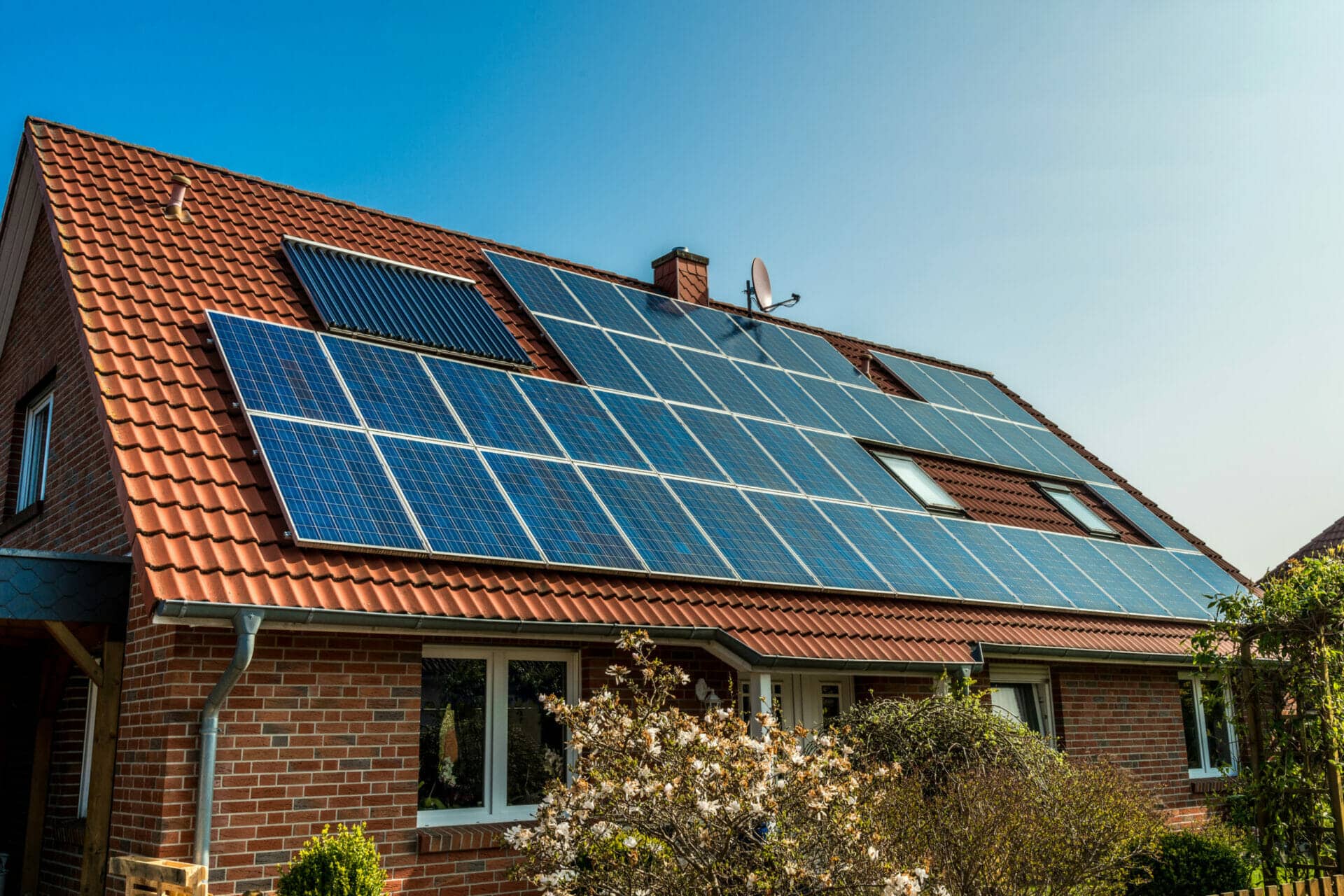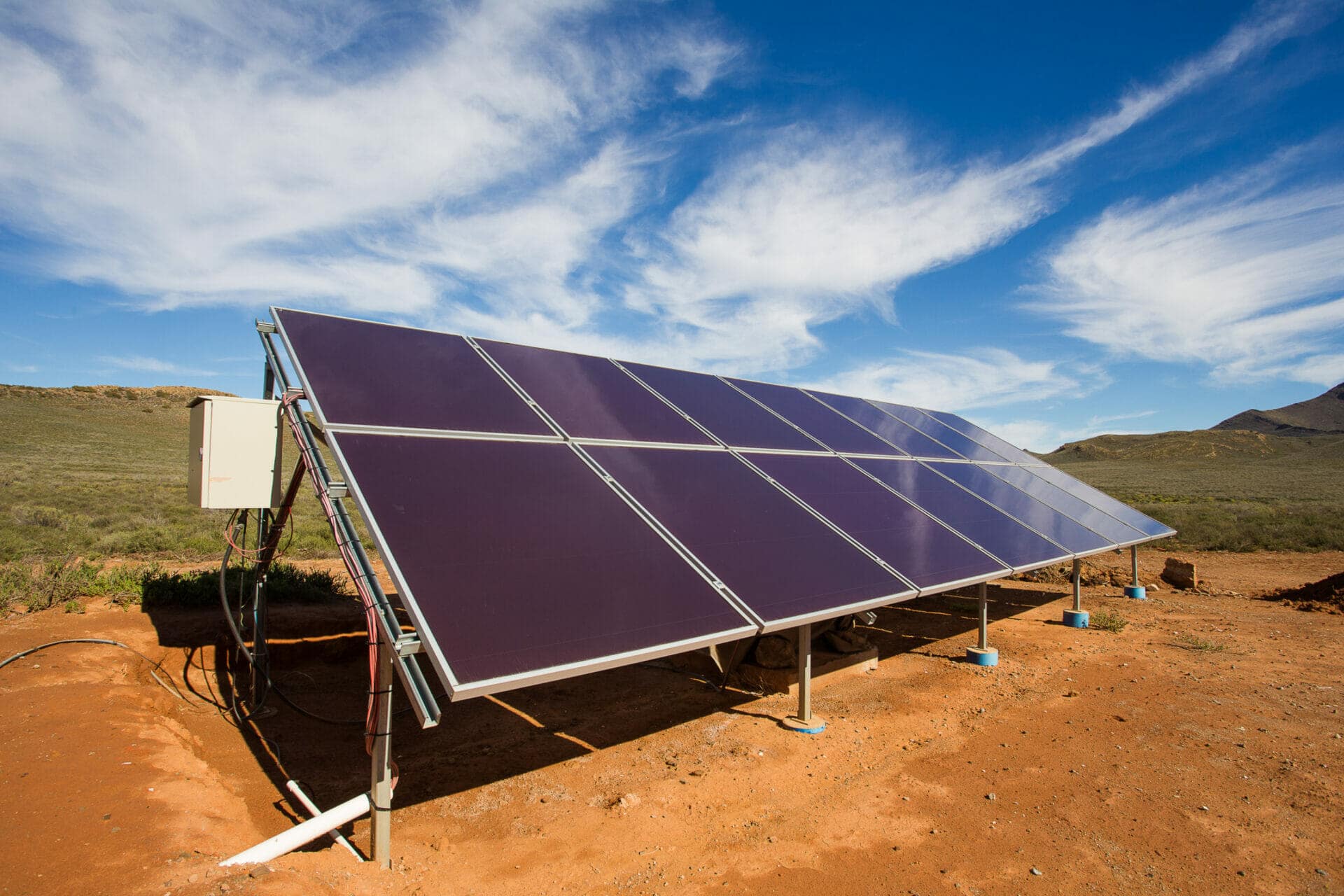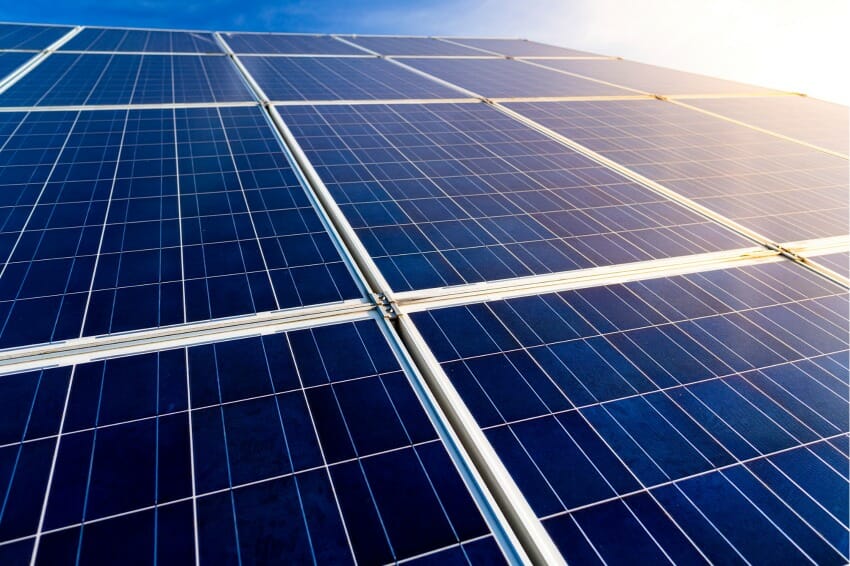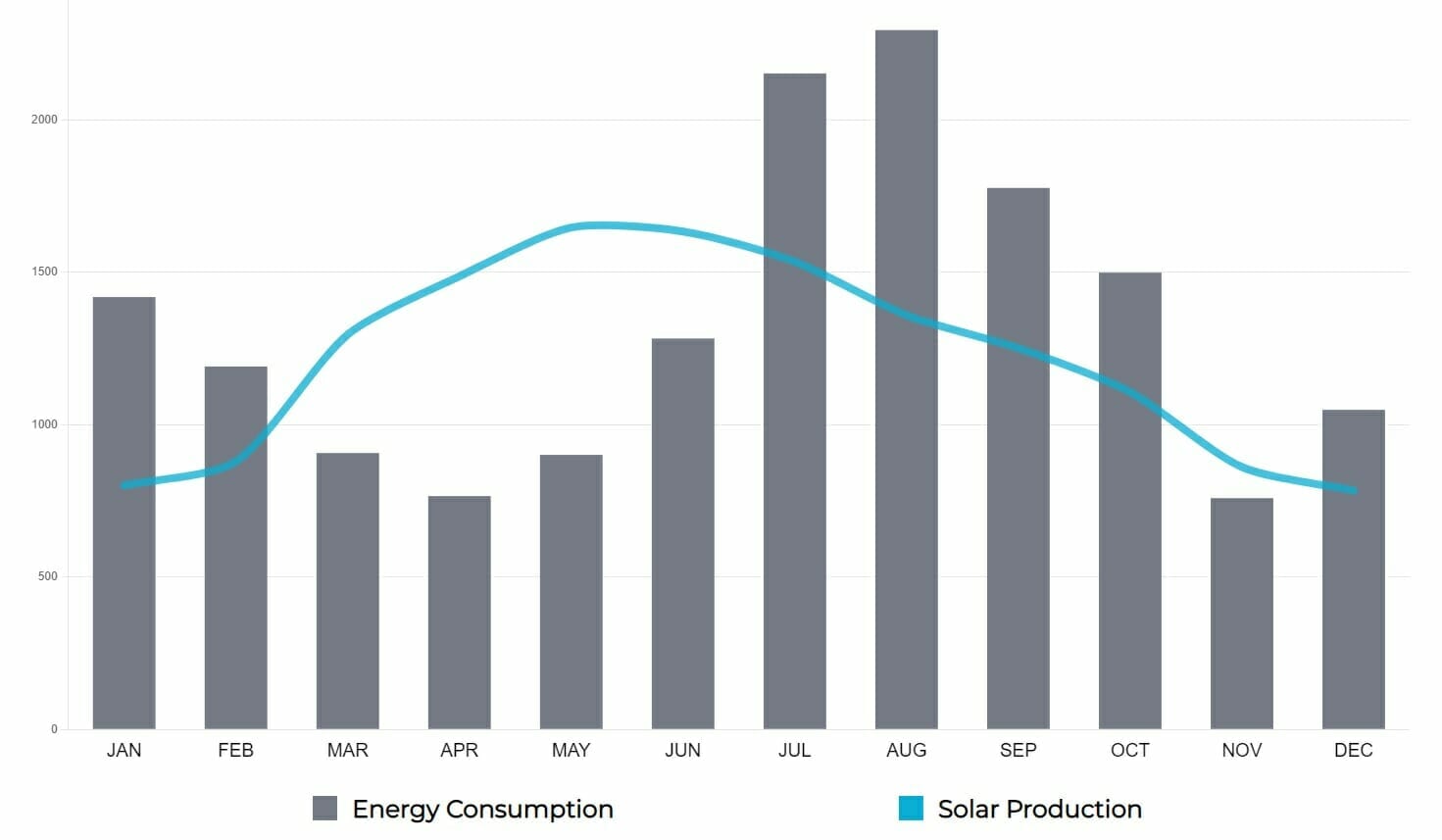Author:
Do you live in Arizona and are you searching for the answer to: “How Many Solar Panels Do I Need?” If so, you have come to the right place. This page is the ultimate guide to solar sizing for houses in the Phoenix metropolitan area and other parts of Arizona.
Factors in Solar Panel System Sizing
There are many factors to consider when sizing a solar system. Here are some of the most important considerations when calculating how many solar panels you need:
- Your goals with solar power;
- Amount of electricity in kilowatt-hours (kWh) used at your home in the last 12 months;
- Physical dimensions, wattage, and efficiency of the panels used;
- Amount of roof space you have available (or land available for a ground mount);
- How your electric utility interacts with residential solar systems;
- Whether you will install a grid-tied system or an off-grid system; and
- The location, climate, and amount of sunlight in your area.
Common Questions – Solar Panel System Sizing
- How many solar panels to power a house?
- How many solar panels do you need for a house?
Schedule Your Free Solar Consultation
Average Solar System Size
The Phoenix, AZ area is unique because it is the second sunniest place on earth behind Yuma, AZ. Phoenix gets around 300 days of full sunshine every year. It also gets extremely hot in Phoenix, so air conditioning units run most of the day in the summer.
This means that the average size of solar systems in Phoenix is larger than the rest of the country because AC units draw a lot of power.
Solar installers build bigger 100% to 110% offset systems in the APS utility because of their high buyback rate. We build smaller 50% to 75% offset systems in the SRP utility because of SRP’s low buyback rate and high grid fee.
Common Questions – Average Solar System Size:
- What is the average number of solar panels per house?
- What is the number of solar panels for an average house?
How Much Solar Panels Do I Need for a Grid Tied System in Phoenix, AZ?
The below table shows home square footage, average usage per square footage, system size needed in kilowatts (kW), number of solar panels needed, and the target production of the solar system to maximize savings.
TABLE – Solar Panels Needed for a Grid Tied System in Phoenix AZ
Home Sq. Ft. Avg Usage (kWh) System Size Needed (kW - APS) Panels Needed (APS) Target Production (kWh - APS) System Size Needed (kW - SRP) Panels Needed (SRP) Target Production (kWh - SRP)
500 4,500 3.2 9 4,725 2.2 6 3,150
1,000 9,000 6.5 17 9,450 4.3 12 6,300
1,500 13,500 9.7 26 14,175 6.5 17 9,450
2,000 18,000 12.9 35 18,900 8.6 23 12,600
2,500 22,500 16.2 44 23,625 10.8 29 15,750
3,000 27,000 19.4 52 28,350 12.9 35 18,900
3,500 31,500 22.7 61 33,075 15.1 41 22,050
4,000 36,000 25.9 70 37,800 17.3 47 25,200
4,500 40,500 29.1 79 42,525 19.4 52 28,350
5,000 45,000 32.4 87 47,250 21.6 58 31,500
Common Questions – Grid Tied Solar Systems:
- Solar Panels – How many do I need?
- How many is the average solar panels per house?


Goals with Solar Power
Nearly everyone that lives in a city, and is connected to the grid, goes solar for financial reasons. They are tired of their utility company charging high rates that always increase each year. Solar energy in their area will save them money on their monthly electricity bills.
Financial Goals
Here are the financial benefits of going solar:
- Savings up to 85% on utility bills;
- Locking in a flat monthly payment that never goes up with a fixed interest solar loan;
- Protecting against the utility energy rates that will always keep increasing;
- Taking advantage of the 30% Federal tax credit and $1,000 Arizona tax credit; and
- Increasing home value by 4.1%.
Saving Money with a Grid-Tied System
If you live in the city and are connected to the grid, you will have a grid-tied solar system. If your primary goal is to save money, you will have a smaller sized solar system.
Grid-tied solar systems are only meant to supplement power from the grid, not replace it. Solar batteries are expensive, so most people that want to save money won’t buy them. That means you will be buying power from the grid at night and during the summer when your AC is running.
When a Phoenix Solar Panel Systems consultant sizes your system, we take this into account when choosing the number of panels to put on your roof. We balance the kWh of electricity you will generate with the amount you will buy from the utility company. Striking the right balance between the two will maximize your savings.
See the chart below to see the energy usage vs. solar power generation of an average solar home in the Phoenix, AZ area.
CHART – Average Usage vs. Production of a Grid-Tied Solar System in Phoenix, AZ
Other Goals
Some other common goals with solar are:
- Lowering your carbon footprint and helping the environment;
- Gaining independence and freedom from the utility company;
- Living off the grid completely; and
- Having power when the grid goes down with a solar battery.
If your primary goals are to help the environment, gain independence, or live off the grid, you will have a larger solar system. A larger system means more equipment and more labor, which costs more and lowers your savings.
As you can see with the chart above, saving money requires a solar panel installation where the panels produce less power than energy consumption during the summer. Phoenix, AZ has a high fluctuation in temperatures and AC units guzzle electricity. Due to this, we build systems that overproduce in the winter and underproduce in the summer.
Helping the environment means going to 100% solar power, because the utility companies still use coal and other non-sustainable energy sources. Gaining independence and self-reliance means not buying any power from the utility. Further, living off grid means you must always overproduce your consumption because there is no grid attached to buy electricity from. All of this means more solar panels and a larger system.
Solar Panels Required to Power a House Off Grid
Determining how many solar panels are needed for an off grid home is going to depend on how many batteries you have. As we mentioned, the solar system has to produce enough electricity to power the AC unit(s) in the summer in the Phoenix area.
This means that the combination of solar power generated and the amount stored in the batteries always has to be enough to power all the large appliances in the home, including the AC. If you have more batteries, you will need slightly less solar panels. However, when building an off grid system in the Phoenix area, there is no way of escaping the expensive purchase of a large system with many solar panels.
The table below shows how many solar panels are needed needed for an average off grid home.
TABLE – Solar Panels Needed for an Off Grid System in Phoenix, AZ
Home Sq. Ft. Avg Usage (kWh) System Size Needed (kW) Panels Needed Target Production (kWh)
500 4,500 5.7 15 8,322
1,000 9,000 11.4 31 16,644
1,500 13,500 17.1 46 24,966
2,000 18,000 22.8 62 33,288
2,500 22,500 28.5 77 41,610
3,000 27,000 34.2 92 49,932
3,500 31,500 39.9 108 58,254
4,000 36,000 45.6 123 66,576
4,500 40,500 51.3 139 74,898
5,000 45,000 57.0 154 83,220
Common Questions – Off Grid Solar Systems
- What solar system do I need off grid?
- How many solar panels do I need for off grid?
Schedule Your Free Solar Consultation
Amount of Electricity Used at Your Home
In the solar industry, we look at electricity production and usage over the course of a year. So you need to determine how many kilowatt-hours (kWh) of electricity you consumed in your home over the last 12 months.
We have a guide on how to get your energy usage in SRP online. The process is similar on the APS website.
Solar Panel Dimensions and Roof Space
The average size of a solar panel is 5.41 feet (65 inches) by 3.25 feet (39 inches).
Your roof space will determine how many panels you can fit on it. If you have limited roof space, you will need less panels with higher wattage to meet your energy needs. Higher wattage panels
For example, two story homes in Phoenix use 1.5 to 2 times the energy of a single story house, but the roof space is the same. To produce the electricity needed, higher wattage panels must be used.
If you have plenty of roof space, you can go with lower wattage panels that are less expensive.
Common Questions – Dimensions and Roof Space
- What is the average size of a solar panel?
- How many solar panels can I fit on my roof?
- How many square feet of solar panels do I need?


Solar Panel Wattage
The average wattage of Tier 1 panels is 300 to 400 watts.
Solar panel watts are the expected electricity production per hour under ideal sunlight conditions. Panels with higher wattage produce more electricity per hour, but they usually cost more. Panels with lower wattage
With higher wattage, you will need less panels to hit your target production. With lower wattage, you will need more panels to hit your target production.
Solar Panel Efficiency
The average efficiency of Tier 1 panels is between 15% and 20%. Production ratio is the amount of kWh your solar panel system will produce in a year divided by the system size wattage. Efficiency ratings and production ratios show you the amount of energy in sunlight that is converted into usable electricity. The higher the efficiency, the more sunlight the panels turn into electricity.
The higher the efficiency of the panels, the less panels you will need. The lower efficiency of the panels, the more panels you will need.
Generally speaking, panels that have higher wattage and efficiency ratings are more expensive than panels with lower wattage and efficiency ratings.
Electric Utility Interaction with Solar
The amount of panels you need largely depends on how your electric utility company interacts with residential solar systems. Some utilities allow you to save more money with solar, and others allow you to save less money.
The utility companies typically lose profits when residential customers go solar. The utilities would prevent everyone from going solar if they could, because they want 100% control over how you get your electricity. When they have a monopoly and total control over your electricity, they can make more money off you.
When you get electricity from a solar system that you own, the utilities have less control over you, and this reduces their profits. However, utility companies are forced to allow residential solar due to laws that require the grid to be powered by renewable resources.
Schedule Your Free Solar Consultation
APS Solar Offset
In APS you want to build a 100% to 110% offset system.
This means that the yearly production of your solar system produces 100% to 110% of the energy you used in your home over the last year. So if you used 10,000 kWh over the last year, you want a solar system that produces 10,000 kWh to 11,000 kWh per year.
The reason it is ideal to build a 100% to 110% system in APS is because of the following:
- APS has a high solar buyback rate, so you get paid well when you are sending a large amount of electricity to the APS grid in the winter when your AC is not running;
- APS does not offer discounted electricity rates after you go solar, so you want to buy the least amount of electricity from APS as possible; and
- APS has a low grid fee that is eliminated by the credits you receive when exporting electricity to the grid, so you want to produce extra energy.
SRP Solar Offset
In SRP you want to build a 50% to 75% offset system.
The reason it is ideal to build a 50% to 75% system in SRP is because of the following:
- SRP has a lower buyback rate, so you want to limit the amount of electricity you send to the SRP grid;
- SRP offers discounted utility rates after you go solar, so you want to supplement your solar electricity with power from SRP’s grid to save the most amount of money; and
- SRP has a high grid fee that you cannot eliminate with export credits, so you want to produce less energy.
On Grid vs. Off Grid Solar System Sizes
When you have a grid tied system, you need less panels because part of your electricity is coming from the grid. When you have an off grid system, you need more panels because you are producing 100% of your own power.
See the charts above for how many solar panels are needed to power a house on the grid and off the grid.


Location, Climate, and Amount of Sunlight
When you have a grid tied system, you need less panels because part of your electricity is coming from the grid. When you have an off grid system, you need more panels because you are producing 100% of your own power.
See the charts above for how many solar panels are needed to power a house on the grid and off the grid.
How many solar panels to power a home in Phoenix, Arizona?
We are fortunate because Phoenix is the 2nd sunniest place on Earth behind Yuma, AZ. Phoenix gets about 300 fully sunny days per year. We are also in the northern hemisphere and relatively close to the equator, which allows the panels to easily collect sunshine.
The sun is out for a long period of time for all of the year, especially in the summer. Phoenix gets 9 hours and 56 minutes of daylight in the winter and 14 hours and 22 minutes in the summer.
The Phoenix area is an ideal location for solar panels because each solar panel on your roof is maximizing its electricity production. This means you need less panels in the Phoenix area to produce the same amount of electricity as a larger system in a less ideal location like Seattle.
How many solar panels for a house in Seattle, Washington?
Residential solar is not nearly as popular in the Seattle, Washington area because they only get 71 days of full sunshine. Seattle is also the cloudiest city in the Lower 48 states with 226 days of clouds covering more than three-quarters of the sky. Cloudcover reduces the electricity production of solar panels by 10% to 25%.
In Seattle, you would need more solar panels to produce the same amount of electricity as a smaller system in Phoenix.
How many panels do I need for solar in Anchorage, Alaska?
Alaska only receives 5 hours and 27 minutes of daylight in the winter, which makes it difficult for the solar panels to collect energy. Further, Alaska is close to the north pole, which means the sun is very low in the sky. This oblique angle of sunlight means the solar panels need to be placed on the side of a house. It lowers the efficiency and electricity collection ability of the solar panels.
Alaska is also the cloudiest location in the United States, with some places getting more than 340 cloudy days per year. In Anchorage, you would need more solar panels to produce the same amount of electricity as a smaller system in Seattle.



